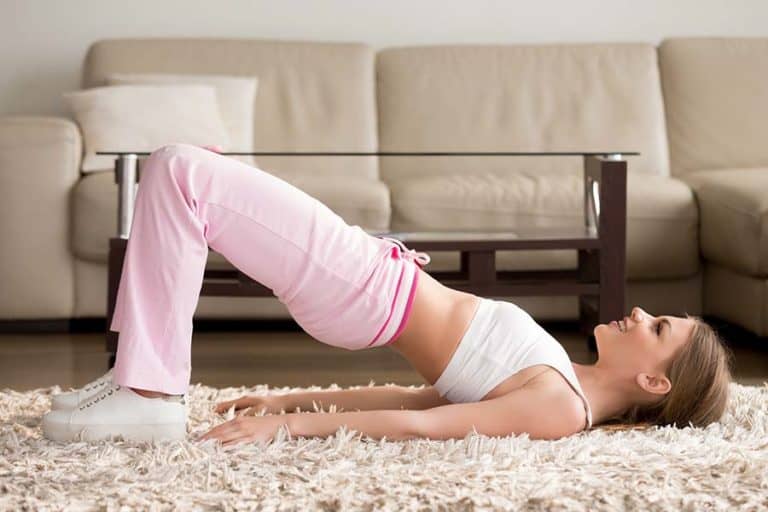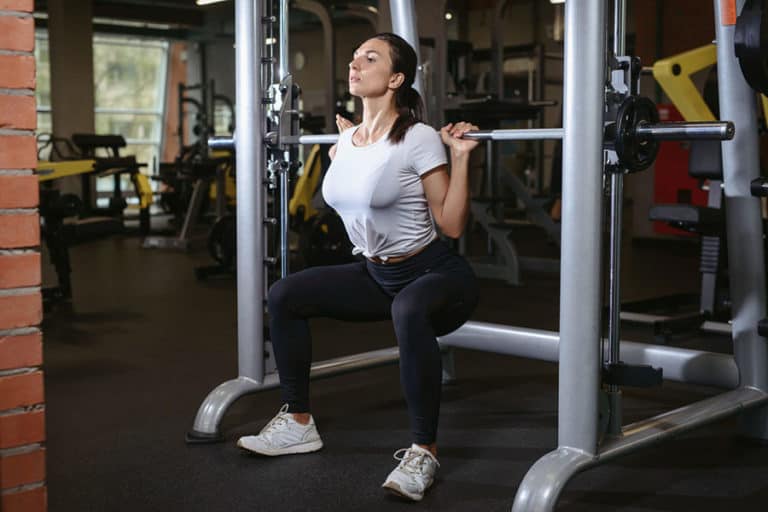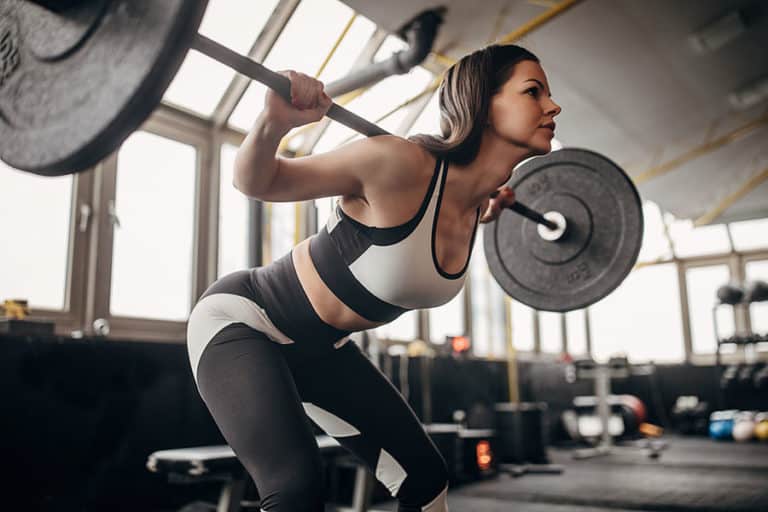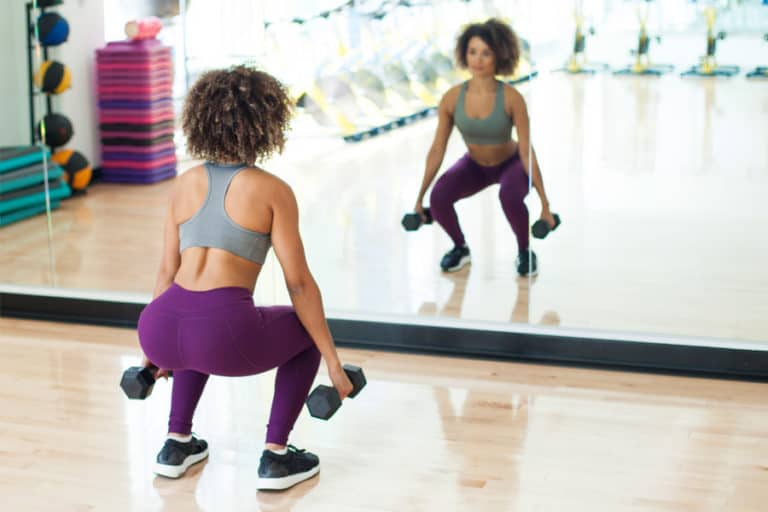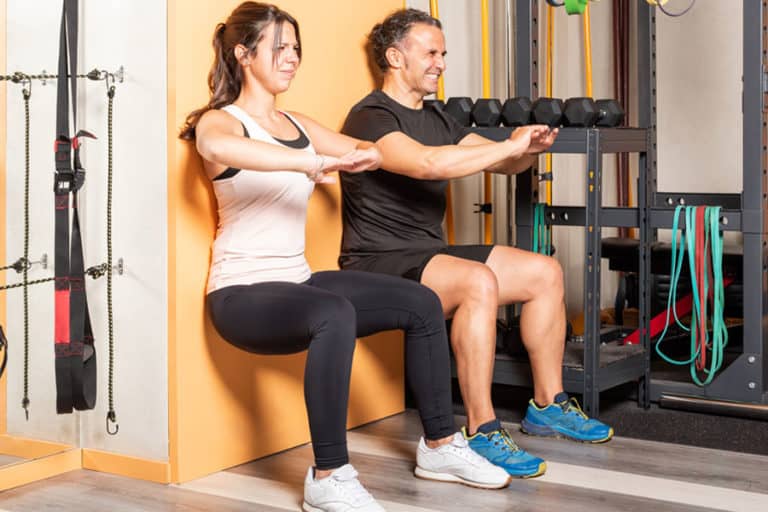Step-Up and Get Fit: What Muscles Does The StairMaster Work?
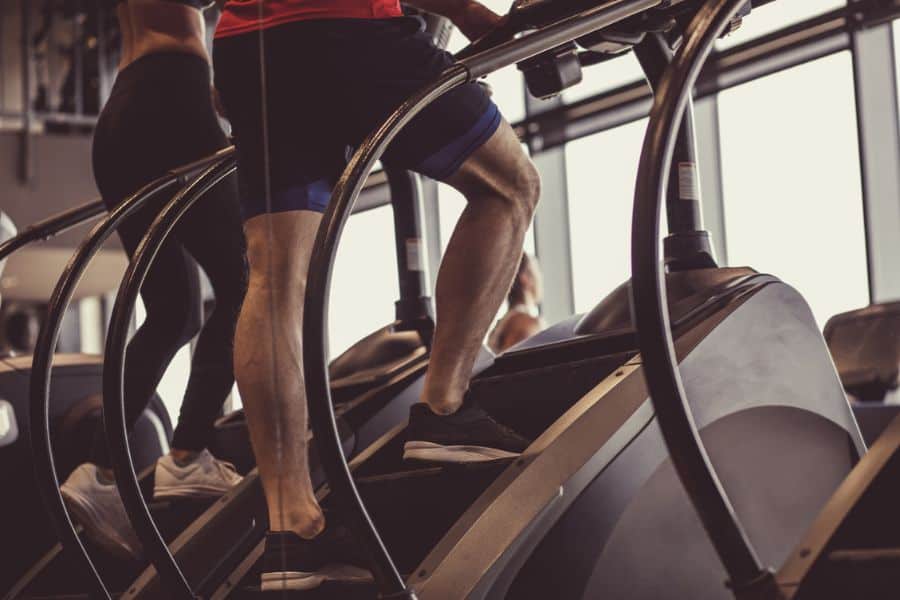
Muscles Worked | How To Use | Proper Form | Sample Workout | Variations | Benefits | Calories Burned | StairMaster vs Cardio Equipment | FAQs
The StairMaster is an amazing cardiovascular exercise machine that has been steadily growing in popularity among fitness enthusiasts. This equipment has rotating steps that simulate the act of climbing stairs that provide an above-average cardio workout.
But in more specific terms, what muscles does the Stairmaster work?
Primarily, the Stairmaster uses body weight and stair climbing motion to target the glutes, quadriceps, hamstrings, and calf muscles. But it also provides an excellent core and upper body workout.
Additionally, as a piece of cardio equipment, the Stairmaster benefits your heart and lung health, increasing overall cardiovascular fitness.
What muscles does the Stairmaster work?
The Stairmaster is a versatile exercise machine that targets multiple muscle groups. Incorporating it into a regular workout routine can help strengthen and tone the lower body muscles while increasing general cardiovascular fitness.
Here’s how the Stairmaster works various muscle groups:
Primary Muscle Groups Targeted by the Stairmaster
- Quadriceps: The quads are the muscles in the upper front of the legs. Stepping down on the Stairmaster requires driving the step through the quadriceps, and higher resistance settings can further engage these muscles. Walking upright can help focus the training on the quadriceps.
- Hamstrings: The hamstrings, located at the back of the legs, are also targeted by the Stairmaster. Lifting the feet up to keep moving on the Stairmaster requires the hamstrings to contract. Faster settings can challenge and develop these muscles. Walking with a quick pace and slightly forward can place more emphasis on the hamstrings.
- Glutes: The glutes, which are the largest muscles in the body, are worked in both directions on the Stairmaster when pushing down and pulling up. Leaning forward or setting the machine at a higher resistance can further target the glutes, making the Stairmaster a great exercise for these muscles.
- Calves: The calf muscles are very often neglected in training. The stair-climbing movement of the Stairmaster is quite effective for training the calf muscles. Placing the weight on the balls of the feet and staying upright can help focus on the calves during the workout.
Secondary Muscle Groups Targeted by the Stairmaster
- Core muscles: In addition to the lower body muscles, the Stairmaster machine also targets the abdominal and core muscles. Balancing oneself while climbing the stairs on the Stairmaster activates the core and stabilization muscles, which are often overlooked in traditional workouts. Walking upright with hands at the sides instead of holding onto the machine can help engage the abdominal muscles.
- Upper body muscles: While the primary focus of the Stairmaster is on the lower body, it can also engage some upper body muscles, such as the arms and shoulders, to a lesser extent. However, this may require you to modify the stair climber workout or try variations of the same.
How to use a Stairmaster?
Before you invest in a stairmaster or decide to use one at the gym, make sure that you know how to use these machines. Here’s a simple step-by-step guide on how to workout safely and effectively on a Stairmaster:
- Ensure the machine is stable: Make sure the Stairmaster is standing securely on a level and stable surface to avoid any wobbling or instability that could pose an injury risk.
- Step on with caution: Stand by the machine and place both hands on the rails for support as you step up with either foot, placing the whole foot on the stairs. Avoid staying on the first step. Settle mid-height on the stair climber before starting it to avoid sudden movements that could cause loss of balance.
- Position your feet: Place your feet flat on the stairs, shoulder-width apart, to maintain a stable and balanced stance.
- Start slow: Turn the Stairmaster on and select your desired workout variation. If you’re a beginner, consider reaching out to a personal trainer to help you get started. Begin at a slow speed to warm up your muscles and get used to the rhythm of the machine before adjusting the speed.
- Watch your step when dismounting: When you’re done with your workout, wait for the Stairmaster to come to a complete stop before stepping off. Use the handles or rails for support to avoid slipping or tripping, and step off the machine carefully.
- Re-energize with fluids: The Stairmaster can be an intense workout that taps your energy. After your workout, replenish your fluids by drinking water or a drink containing electrolytes to replace the minerals lost through sweat during your workout.
Proper Form for Using the Stairmaster
Proper form and technique are crucial when using the Stairmaster. By maintaining proper form and technique, you can maximize the benefits of your Stairmaster workout and reduce the risk of injury. Follow these tips to maintain proper form on the Stairmaster:
- Keep your back straight and shoulders relaxed.
- Engage your core muscles to maintain stability and balance.
- Place your feet flat on the pedals and avoid leaning forward or backward.
- Use the handrails for balance only, and avoid leaning heavily on them.
- Step through the entire range of motion, fully extending your legs and lifting your feet off the pedals.
- Avoid excessive gripping of the handrails, allowing your arms to move naturally with the stepping motion.
- Start with a moderate pace and gradually increase the intensity as your fitness level improves.
- Maintain a smooth and controlled motion, avoiding jerky movements or bouncing.
- Avoid locking your knees at the top of the step to prevent strain on the joints.
- Listen to your body and stop if you feel pain or discomfort, adjusting the intensity or taking breaks as needed.
Sample Stairmaster Workout Routine
A Stairmaster workout routine can be tailored to different fitness levels, from beginners to advanced users. Here is a table with 3 sample routines to give you an idea of how to structure your workout:
| Beginner | Intermediate | Advanced | |
| Duration | 20-30 min | 30-45 min | 45-60 min |
| Intensity | Low to Moderate | Moderate to High | High |
| Warm-up | 5 min of light walking or stretching | 5-10 min of light cardio (brisk walking or cycling) | 10 min of moderate cardio (jogging or cycling) |
| Main Workout | 10-15 min of continuous stepping, gradually increasing intensity | 20-30 min of continuous stepping, incorporating intervals of high intensity and active recovery | 30-45 min of continuous stepping, incorporating intervals of high intensity and active recovery |
| Cool-down | 5 min of easy stepping, calf, quadriceps, and hamstring stretches | 5-10 min of easy stepping, stretches for calves, quadriceps, hamstrings, glutes, and core | 5-10 min of easy stepping, thorough stretches for major muscle groups, holding each stretch for 20-30 seconds |
(Note: It’s important to customize your workout routine based on your fitness level, goals, and any health considerations you may have. It’s always recommended to consult with a healthcare professional or a certified fitness trainer before starting a new exercise routine.)
Stairmaster Exercise variations
The Stairmaster offers a variety of exercise variations that can target different muscles and add variety to your workout. Here are some examples:
- Sideways Steps: Step sideways on the Stairmaster, leading with one foot, then switch directions to work your inner and outer thighs, hips, and glutes.
- Single-Leg Steps: Place one foot on the Stairmaster and lift the other leg off the step, stepping up and down with only one leg at a time. This variation challenges your balance and stability, while also targeting your quadriceps, hamstrings, and glutes on the working leg.
- Explosive Jumps: Instead of steady stepping, perform explosive jumps on the Stairmaster, jumping from one step to another, engaging your leg muscles and adding a plyometric element to your workout. This variation increases the intensity of your workout and can help improve power and explosiveness in your lower body.
- Handrail-Free Stepping: Challenge your balance and stability by keeping your arms off the handrails and relying solely on your legs and core for support. This variation helps improve your balance, coordination, and core strength.
- High Knee Steps: Lift your knees higher with each step, engaging your hip flexors, abdominals, and quadriceps for a more challenging cardio and strength workout. This variation increases the intensity of your workout and helps improve your hip and core strength.
Other Muscles Worked Through Stairmaster Variations
While the Stairmaster primarily targets your lower body muscles, some variations can also engage other muscles.
Using different hand positions or performing handrail-free stepping can engage your biceps, triceps, latissimus dorsi, rhomboids, and deltoids, providing an additional upper body workout.
Benefits of Using the Stairmaster
Incorporating the Stairmaster into your fitness routine can offer numerous benefits, including improved cardiovascular health, calorie burn, muscle strengthening, bone health, core strength, balance, and mental well-being. It is a versatile and effective exercise machine that can contribute to overall fitness and well-being with consistent use.
Here are the top 12 benefits of working out regularly with the Stairmaster:
1. Improves Heart and Lung Health
Stair climbing activities are known to significantly improve cardiorespiratory health [1]National Library of Medicine: Home-Based Stair Climbing as an Intervention for Disease Risk in Adult Females; A Controlled Study. Consequently, Stair stepper machines like the Stairmaster can promote both heart and lung health by providing intense aerobic workout.
2. Burns Calories
The intense workout provided by the Stairmaster helps burn a significant number of calories, making it an effective tool for weight loss and weight management. The continuous stair climbing motion engages multiple muscle groups, resulting in a high-calorie burn and increased metabolism even after the workout. You can expect to burn anywhere between 180-260 calories [2]Harvard Health Publishing: Calories burned in 30 minutes for people of three different weights after a 30-minute workout on the Stairmaster.
3. Strengthens Quadriceps and Hamstrings
The Stairmaster specifically targets the quadriceps and hamstrings, the muscles of the upper legs. The repetitive stair climbing motion helps to tone and strengthen these muscles, leading to improved leg strength and endurance.
4. Strengthens Calves and Glutes
In addition to the quadriceps and hamstrings, the Stairmaster also engages the calf muscles and glutes. Regular use of the Stairmaster can lead to toned and strengthened calves and glutes, resulting in improved lower body strength and aesthetics.
5. Boosts Bone Health
The Stairmaster is a weight-bearing exercise that helps improve bone density, making it an excellent workout for promoting bone health and preventing osteoporosis. The repetitive impact of climbing stairs stimulates bone growth and helps maintain strong and healthy bones.
6. Increased Core Strength
The Stairmaster requires balance and stability, which engages the core muscles. Regular use of the Stairmaster can lead to increased core strength, improved posture, and enhanced stability and balance in daily activities.
7. Muscle Building and Endurance
The Stairmaster provides a challenging workout that targets multiple muscle groups, resulting in increased muscle hypertrophy [3]ScienceDirect: Muscle Hypertrophy and improved endurance. Consistent use of the Stairmaster can lead to increased muscle strength, stamina, and overall physical performance.
8. Improves Balance and Coordination
The repetitive stair climbing motion of the Stairmaster helps improve balance and coordination. The consistent use of the Stairmaster can lead to enhanced proprioception, coordination, and stability, reducing the risk of falls and injuries in daily life.
9. Puts Less Strain on the Body
The Stairmaster provides a low-impact workout that puts less strain on the joints compared to other forms of cardiovascular exercises such as running or jumping. This makes it an ideal option for individuals with joint issues or injuries, allowing them to engage in a challenging workout without exacerbating joint pain.
10. Eases Knee Pain
Contrary to popular belief, the Stairmaster can actually help ease knee pain in individuals with knee issues. The controlled and repetitive motion of stair climbing helps strengthen the muscles around the knees, providing stability and support, which can alleviate knee pain and discomfort.
11. Improves Mental Health
Exercises in general, and aerobic exercises in particular, are known to have a neuromodulatory impact. [4]National Library of Medicine: Neuromodulation of Aerobic Exercise—A Review That is, they reduce stress hormones and release “feel-good” hormones in the body.
Like any form of exercise, the Stairmaster can improve mental health by reducing stress, releasing endorphins, and promoting a sense of well-being. Regular use of the Stairmaster can contribute to improved mood, reduced anxiety and depression, and enhanced cognitive function.
12. Improves Overall Fitness
The Stairmaster is a versatile and effective exercise machine that provides a full-body workout, improving overall fitness levels. It combines cardiovascular exercise, strength training, and balance and coordination training, making it a comprehensive workout option for improving overall physical fitness and well-being.
Calories Burned by Stairmaster
Scientific evidence suggests that the Stairmaster is a highly effective tool for burning calories and aiding in weight and fat loss.
Compared to walking on a treadmill, stair-stepping has been found to burn significantly more calories. Estimates range from 128 to 260 calories burned in a 30-minute session, depending on factors such as body weight and workout intensity.
The higher calorie burn can contribute to improved overall health by reducing the risk of various diseases and promoting a more toned appearance as body fat decreases and muscles become more visible.
Many Stairmaster machines are equipped with built-in calorie calculators that provide an estimate of calories burned based on the user’s weight, further aiding in tracking progress and managing weight.
StairMaster vs Other Cardio Equipment
StairMaster is a popular piece of fitness equipment designed to mimic the motion of climbing stairs. It provides an effective cardiovascular workout that targets the lower body muscles, including the glutes, quads, and calves.
Since there are other types of cardio equipment available in the market, let’s find out how StairMaster is different from them.
Quick glance – StairMaster vs Other Cardio Equipment
| Criteria | StairMaster | Treadmill | Incline Treadmill | Stair Stepper |
| Calories burned | High | Moderate | High | Moderate |
| Muscle engagement | Lower body | Upper & Lower | Upper & Lower | Lower body |
| Impact on joints | Low | High | Low | Low |
| Motion type | Vertical | Horizontal | Incline | Vertical |
| Beginner-friendly | Challenging | Easy | Easy | Varies |
| Customization options | High | Moderate | High | Low |
Note: This table is based on general comparisons and may not apply to every specific brand or model of each type of equipment.
StairMaster vs. Treadmill
StairMaster tends to burn more calories compared to walking on a treadmill, making it a more effective option for weight and fat loss.
StairMaster primarily targets lower body muscles, while treadmill engages both upper and lower body muscles.
StairMaster provides a high-intensity, low-impact workout, while treadmill offers a higher impact workout.
StairMaster offers a vertical climbing motion, while treadmill provides a horizontal walking or running motion.
StairMaster may be more challenging for beginners due to its higher intensity and the need to maintain balance.
StairMaster vs. Incline Treadmill
Both StairMaster and incline treadmill provide an intense cardiovascular workout.
StairMaster focuses primarily on lower body muscles, while incline treadmill engages both upper and lower body muscles.
Incline treadmill allows for varying levels of incline, simulating uphill walking or running, while StairMaster provides a continuous vertical climbing motion.
Incline treadmill may be more joint-friendly compared to StairMaster, as it reduces impact on joints due to its walking or running motion.
StairMaster may be more challenging for individuals with balance issues, while incline treadmill provides a more stable walking or running surface.
StairMaster vs. Stair Stepper
StairMaster and stair stepper are often used interchangeably to refer to the same type of exercise equipment.
Both StairMaster and stair stepper provide a vertical climbing motion, targeting lower body muscles.
StairMaster is a brand name for a specific type of stair stepper that offers a variety of features and intensity levels.
Stair stepper is a more general term that can refer to different brands and types of equipment with varying levels of intensity.
StairMaster may offer more advanced features and customization options, while stair stepper may be more basic and suitable for beginners.
Conclusion
In conclusion, the StairMaster is a versatile and effective exercise machine that targets various lower body muscles, providing a challenging cardiovascular workout. By engaging muscles such as the quadriceps, hamstrings, glutes, and calves, the StairMaster can help improve muscle strength, endurance, and tone, making it a valuable addition to any fitness routine for those looking to step up their fitness goals and achieve a more toned and healthy body.
FAQs
What will the StairMaster do for my body?
The StairMaster can help improve muscle strength and endurance, primarily targeting lower body muscles such as quadriceps, hamstrings, glutes, and calves, resulting in a toned appearance.
Does StairMaster burn belly fat?
Yes, the StairMaster can contribute to burning belly fat indirectly by burning a significant number of calories in a short amount of time. Regular use of the StairMaster, combined with a healthy diet and overall exercise routine, can help reduce visceral fat around the midsection and strengthen the core muscles.
Does the StairMaster build muscle?
While the StairMaster primarily focuses on cardiovascular exercise, it can also contribute to muscle building, especially in the lower body muscles.
How long should I be on the StairMaster?
The duration of your StairMaster workout depends on your fitness level and goals. Beginners may start with 15-20 minutes, while intermediate and advanced users may aim for anywhere between 30-60 minutes per session. It’s important to listen to your body and gradually increase intensity and duration as you progress.
References
| ↑1 | National Library of Medicine: Home-Based Stair Climbing as an Intervention for Disease Risk in Adult Females; A Controlled Study |
|---|---|
| ↑2 | Harvard Health Publishing: Calories burned in 30 minutes for people of three different weights |
| ↑3 | ScienceDirect: Muscle Hypertrophy |
| ↑4 | National Library of Medicine: Neuromodulation of Aerobic Exercise—A Review |



